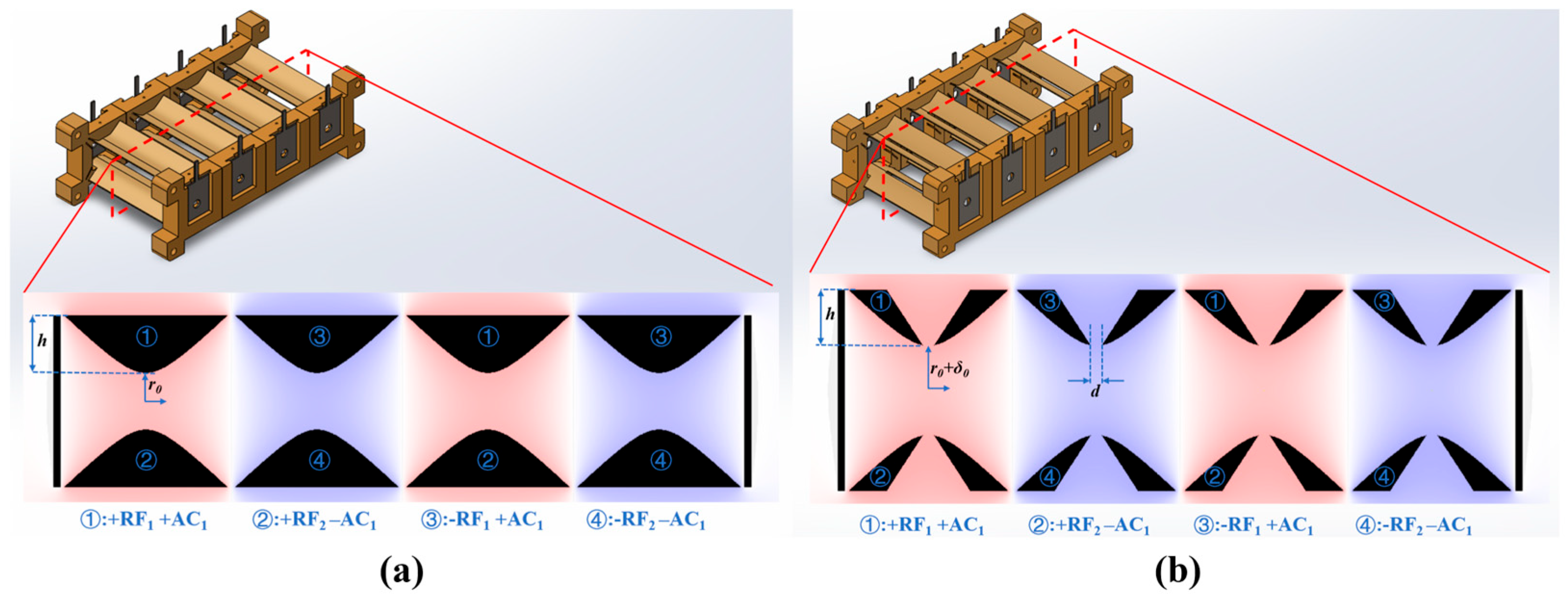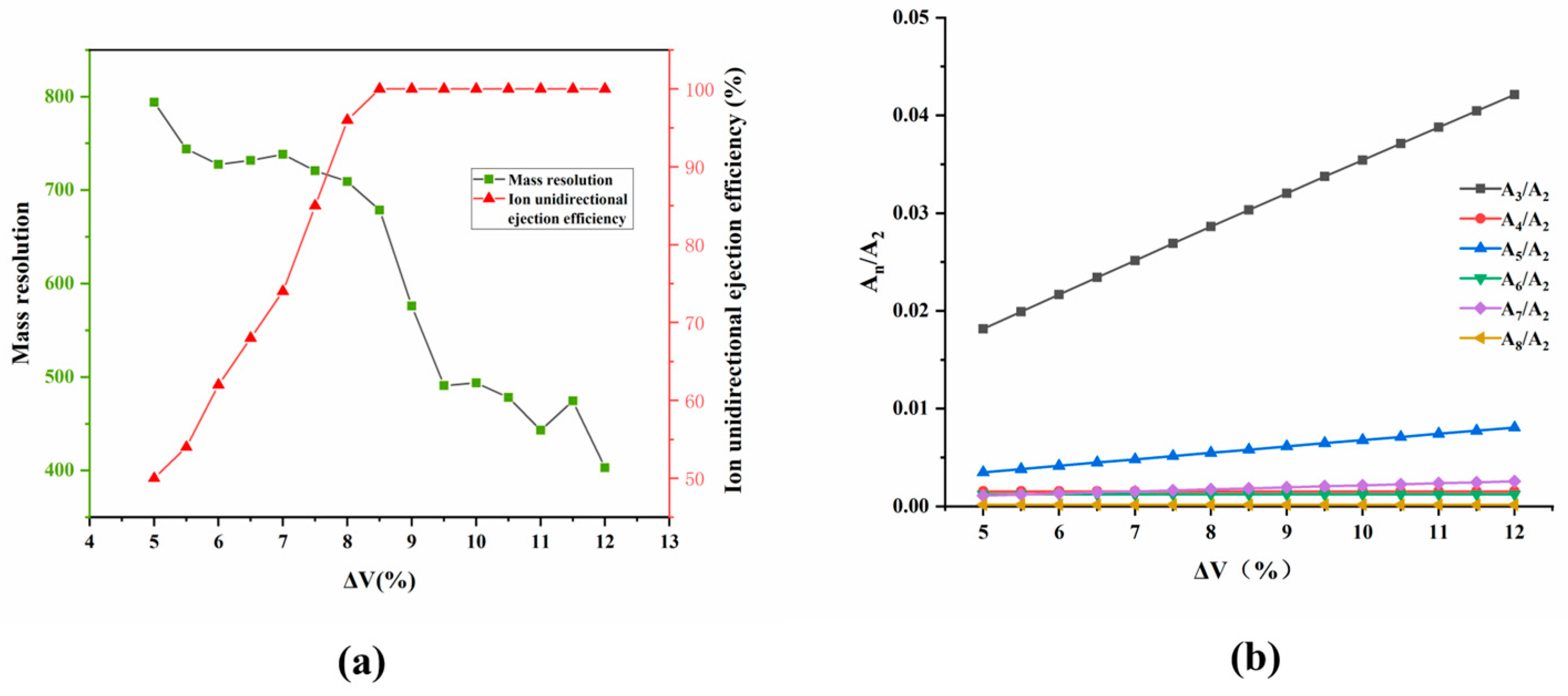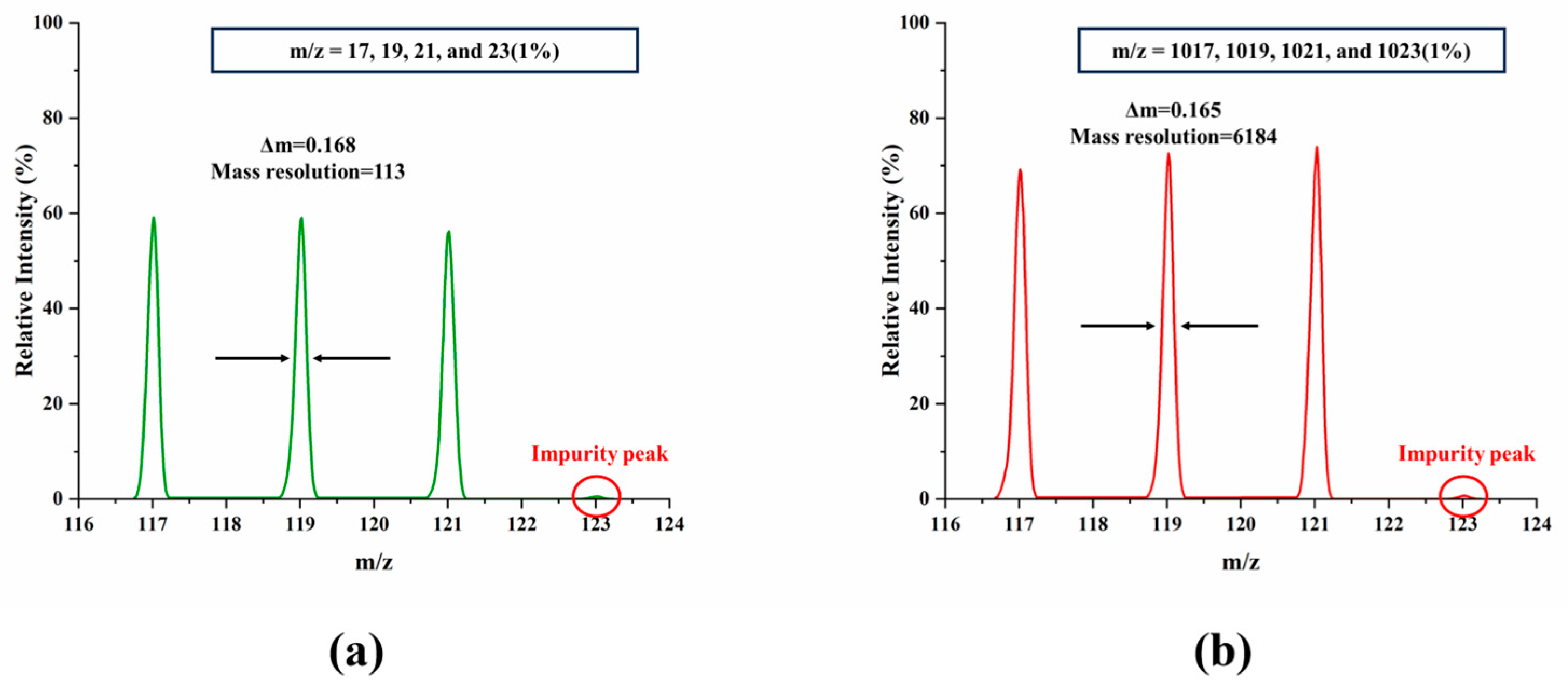Simulation of Unidirectional Ion Ejection in Miniature Four-Channel Linear Ion Trap Array
Abstract
1. Introduction
2. Materials and Methods
2.1. Structure of M-FLITA
2.2. Electric Field Calculation and Ion Trajectory Analysis
3. Results and Discussion
3.1. Performance of the Ideal Structure M-FLITA
3.1.1. Mass Resolution of the Ideal Structure M-FLITA
3.1.2. Unidirectional Ion Ejection of the Ideal Structure M-FLITA
3.2. Performance of the Stretched Structure M-FLITA
3.2.1. Mass Resolution of the Stretched Structure M-FLITA
3.2.2. Unidirectional Ion Ejection of the Stretched Structure M-FLITA
3.2.3. Influence of m/z and Impurity Ions
3.3. Ion Storage Capacity
4. Conclusions
Author Contributions
Funding
Institutional Review Board Statement
Informed Consent Statement
Data Availability Statement
Acknowledgments
Conflicts of Interest
References
- Li, C.; Chu, S.; Tan, S.; Yin, X.; Jiang, Y.; Dai, X.; Gong, X.; Fang, X.; Tian, D. Towards Higher Sensitivity of Mass Spectrometry: A Perspective From the Mass Analyzers. Front. Chem. 2021, 9, 813359. [Google Scholar] [CrossRef]
- Sun, Y.; Xie, Y.; Xu, X.; Tan, M.; Zhang, F. Application progress of innovative high resolution separation and analysis technology in food safety detection field. Chin. J. Chromatogr. 2023, 41, 952–959. [Google Scholar] [CrossRef]
- Chen, T.; Ge, Y.; Chu, B.; Zhang, P.; Ma, Q.; He, H. Applications of environmental mass spectrometry in atmospheric haze chemistry. Trac-Trends Anal. Chem. 2024, 172, 117614. [Google Scholar] [CrossRef]
- Wang, J.; Pursell, M.E.E.; Devor, A.; Awoyemi, O.; Valentine, S.J.J.; Li, P. Portable mass spectrometry system: Instrumentation, applications, and path to ‘omics analysis. Proteomics 2022, 22, e2200112. [Google Scholar] [CrossRef]
- Burns, D.; Mathias, S.; McCullough, B.J.; Hopley, C.J.; Douce, D.; Lumley, N.; Bajic, S.; Sears, P. Ambient ionisation mass spectrometry for the trace detection of explosives using a portable mass spectrometer. Int. J. Mass Spectrom. 2022, 471, 116735. [Google Scholar] [CrossRef]
- Zhang, W.J.; Zhang, S.Y.; Zhang, X.G.; Ye, Y.Z. Space-based Time of Flight (TOF) mass spectrometer for suprathermal-through-energetic ion measurements-development status and prospects. Chin. J. Geophys.-Chin. Ed. 2022, 65, 3743–3758. [Google Scholar] [CrossRef]
- Celin, S.M.; Sharma, B.; Bhanot, P.; Kalsi, A.; Sahai, S.; Tanwar, R.K. Trends in environmental monitoring of high explosives present in soil/sediment/groundwater using LC-MS/MS. Mass Spectrom. Rev. 2023, 42, 1727–1771. [Google Scholar] [CrossRef]
- Bianco, M.; Ventura, G.; Calvano, C.D.; Losito, I.; Cataldi, T.R.I. Food allergen detection by mass spectrometry: From common to novel protein ingredients. Proteomics 2023, 23, 2200427. [Google Scholar] [CrossRef]
- Chien, H.J.; Zheng, Y.F.; Wang, W.C.; Kuo, C.Y.; Hsu, Y.M.; Lai, C.C. Determination of adulteration, geographical origins, and species of food by mass spectrometry. Mass Spectrom. Rev. 2023, 42, 2273–2323. [Google Scholar] [CrossRef]
- Dou, X.J.; Zhang, L.X.; Yang, R.N.; Wang, X.; Yu, L.; Yue, X.F.; Ma, F.; Mao, J.; Wang, X.P.; Zhang, W.; et al. Mass spectrometry in food authentication and origin traceability. Mass Spectrom. Rev. 2023, 42, 1772–1807. [Google Scholar] [CrossRef]
- Wang, J.Y.; Liu, L.Y.; Jiang, T. Integrating artificial intelligence with miniature mass spectrometry. Green Anal. Chem. 2025, 13, 100281. [Google Scholar] [CrossRef]
- Syms, R.R.A.; Wright, S. MEMS mass spectrometers: The next wave of miniaturization. J. Micromech. Microeng. 2016, 26, 023001. [Google Scholar] [CrossRef]
- Jiang, T.; Zhang, H.J.; Tang, Y.; Zhai, Y.B.; Xu, W.; Xu, H.L.; Zhao, X.Y.; Li, D.Y.; Xu, W. A “Brick Mass Spectrometer” Driven by a Sinusoidal Frequency Scanning Technique. Anal. Chem. 2017, 89, 5578–5584. [Google Scholar] [CrossRef]
- Reinhardt, M.; Quiring, G.; Wong, R.M.R.; Wehrs, H.; Mueller, J. Helium detection using a planar integrated micro-mass spectrometer. Int. J. Mass Spectrom. 2010, 295, 145–148. [Google Scholar] [CrossRef]
- Chang, T.H.; Struk, D.; Navaei, M.; Doroshenko, V.M.; Laiko, V.; Moskovets, E.; Novoselov, K.; Dimandja, J.M.D.; Hesketh, P.J. Separation of volatile organic compounds using a MEMS separation column integrated with ion trap mass spectrometer. Sens. Actuators B-Chem. 2020, 307, 127588. [Google Scholar] [CrossRef]
- Szyszka, P.; Jendryka, J.; Sobków, J.; Zychla, M.; Bialas, M.; Knapkiewicz, P.; Dziuban, J.; Grzebyk, T. MEMS quadrupole mass spectrometer. Sens. Actuators B-Chem. 2024, 411, 135712. [Google Scholar] [CrossRef]
- Kothari, S.; Song, Q.Y.; Xia, Y.; Fico, M.; Taylor, D.; Amy, J.W.; Stafford, G.; Cooks, R.G. Multiplexed Four-Channel Rectilinear Ion Trap Mass Spectrometer. Anal. Chem. 2009, 81, 1570–1579. [Google Scholar] [CrossRef] [PubMed]
- Li, X.X.; Jiang, G.Y.; Luo, C.; Xu, F.X.; Wang, Y.Y.; Ding, L.; Ding, C.F. Ion Trap Array Mass Analyzer: Structure and Performance. Anal. Chem. 2009, 81, 4840–4846. [Google Scholar] [CrossRef] [PubMed]
- Cheng, Y.P.; Liu, Y.J.; Wu, Z.X.; Shen, C.; Li, S.; Wang, H.; Chen, C.L. Concept and simulation of a novel dual-layer linear ion trap mass analyzer for micro-electromechanical systems mass spectrometry. Eur. J. Mass Spectrom. 2024, 30, 150–160. [Google Scholar] [CrossRef] [PubMed]
- Wu, H.; Zhang, L.; Zhang, Z.; Qian, J.; Zhang, S.; Zhang, Y.; Ge, S.; Li, X. Simulation of Unidirectional Ion Ejection in an Asymmetric Half-Round Rod Electrode Linear Ion Trap Mass Analyzer. J. Am. Soc. Mass Spectrom. 2018, 29, 2096–2104. [Google Scholar] [CrossRef]
- Xu, K.; Qiu, J.W.; Zhang, T.; Zhu, H.J.; Zhang, S.; Lu, X.X.; Li, X.X. Simulation of double resonant excitation of ions in an asymmetric linear ion trap mass analyzer. Rapid Commun. Mass Spectrom. 2023, 37, e9625. [Google Scholar] [CrossRef]
- Wu, X.S.; Deng, T.; Chen, W.Y.; Zhang, W.P. Electromagnetic levitation micromotor with stator embedded (ELMSE): Levitation and lateral stability characteristics analysis. Microsyst. Technol.-Micro-Nanosyst.-Inf. Storage Process. Syst. 2011, 17, 59–69. [Google Scholar] [CrossRef]
- Tang, Z.Y.; Shao, X.F.; Huang, J.Z.; Yao, J.Y.; Ding, G.F. Manipulating fluid with vibrating 3D-printed paddles for applications in micropump. Nanotechnol. Precis. Eng. 2019, 2, 95–104. [Google Scholar] [CrossRef]
- Zhang, Q.; Lu, X.C.; Chen, T.; Xiao, Y.; Yao, R.J.; Yao, J.Y. A Miniature Four-Channel Ion Trap Array Based on Non-silicon MEMS Technology. Micromachines 2021, 12, 831. [Google Scholar] [CrossRef]
- He, Y.F.; Yang, Z.Q.; Wang, Y.; Sun, J.W.; Sun, Y.N.; Zhu, L.Y.; Zhang, D.; Wang, F.D.; Liu, M.; Ding, G.F.; et al. Ion Unidirectional Ejection Simulation Study of An Extremely Miniature Hyperbolic Linear Ion Trap. Chin. J. Anal. Chem. 2025, 53, 885–893. [Google Scholar] [CrossRef]
- Franzen, J. The non-linear ion trap. Part 4. Mass selective instability scan with multipole superposition. Int. J. Mass Spectrom. Ion Process. 1993, 125, 165–170. [Google Scholar] [CrossRef]
- Zhao, X.Z.; Granot, O.; Douglas, D.J. Quadrupole excitation of ions in linear quadrupole ion traps with added octopole fields. J. Am. Soc. Mass Spectrom. 2008, 19, 510–519. [Google Scholar] [CrossRef] [PubMed]
- Ouyang, Z.; Wu, G.X.; Song, Y.S.; Li, H.Y.; Plass, W.R.; Cooks, R.G. Rectilinear ion trap: Concepts, calculations, and analytical performance of a new mass analyzer. Anal. Chem. 2004, 76, 4595–4605. [Google Scholar] [CrossRef] [PubMed]
- Sudakov, M.; Douglas, D.J. Linear quadrupoles with added octopole fields. Rapid Commun. Mass Spectrom. 2003, 17, 2290–2294. [Google Scholar] [CrossRef]
- Qiu, C.H.; Li, X.L.; Li, Z.; Yang, L.; Wang, W.M.; Ding, C.F.; Xu, F.X. Simulation study of three new quadrupole ion funnels to improve low-mass ion transmission. Rapid Commun. Mass Spectrom. 2023, 37, e9648. [Google Scholar] [CrossRef]
- Yao, R.J.; He, Y.; Xiao, Y.; Ding, Z.Z.; Yuan, G.Z.; Zhang, Z.Y.; Qian, J.; Zhang, S.G.; Li, X.X. Optimization of Linear Ion Trap Mass Analyzer with Triangular Electrodes by Simulation. Chin. J. Anal. Chem. 2016, 44, 1793–1797. [Google Scholar] [CrossRef]
- Li, X.X.; Zhang, X.H.; Yao, R.J.; He, Y.; Zhu, Y.Y.; Qian, J. Design and Performance Evaluation of a Linear Ion Trap Mass Analyzer Featuring Half Round Rod Electrodes. J. Am. Soc. Mass Spectrom. 2015, 26, 734–740. [Google Scholar] [CrossRef] [PubMed]







Disclaimer/Publisher’s Note: The statements, opinions and data contained in all publications are solely those of the individual author(s) and contributor(s) and not of MDPI and/or the editor(s). MDPI and/or the editor(s) disclaim responsibility for any injury to people or property resulting from any ideas, methods, instructions or products referred to in the content. |
© 2025 by the authors. Licensee MDPI, Basel, Switzerland. This article is an open access article distributed under the terms and conditions of the Creative Commons Attribution (CC BY) license (https://creativecommons.org/licenses/by/4.0/).
Share and Cite
He, Y.; Yang, Z.; Zhang, Y.; Sun, Y.; Yao, J.; Ding, G. Simulation of Unidirectional Ion Ejection in Miniature Four-Channel Linear Ion Trap Array. Sensors 2025, 25, 6701. https://doi.org/10.3390/s25216701
He Y, Yang Z, Zhang Y, Sun Y, Yao J, Ding G. Simulation of Unidirectional Ion Ejection in Miniature Four-Channel Linear Ion Trap Array. Sensors. 2025; 25(21):6701. https://doi.org/10.3390/s25216701
Chicago/Turabian StyleHe, Yunfan, Zhuoqing Yang, Yan Zhang, Yunna Sun, Jinyuan Yao, and Guifu Ding. 2025. "Simulation of Unidirectional Ion Ejection in Miniature Four-Channel Linear Ion Trap Array" Sensors 25, no. 21: 6701. https://doi.org/10.3390/s25216701
APA StyleHe, Y., Yang, Z., Zhang, Y., Sun, Y., Yao, J., & Ding, G. (2025). Simulation of Unidirectional Ion Ejection in Miniature Four-Channel Linear Ion Trap Array. Sensors, 25(21), 6701. https://doi.org/10.3390/s25216701







